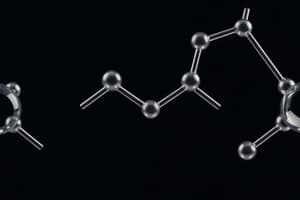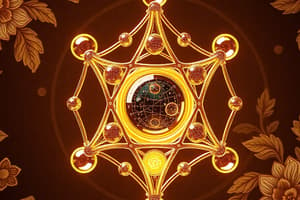Podcast
Questions and Answers
What is the general formula for alcohols?
What is the general formula for alcohols?
- CnH2n+2OH
- CnH2nOH
- CnH2n+1OH (correct)
- CnH2n-1OH
Which statement correctly describes a primary alcohol?
Which statement correctly describes a primary alcohol?
- The -OH group is attached to a carbon bonded to two other carbons.
- The -OH group is attached to a carbon bonded to one other carbon. (correct)
- The -OH group is attached to a carbon bonded to three other carbons.
- The -OH group is attached to a carbon with no other carbons bonded.
In the context of chloroalkanes, which compound is an example of a trichloromethane?
In the context of chloroalkanes, which compound is an example of a trichloromethane?
- Monochloromethane
- Chloroform (correct)
- Dichloromethane
- Tetrachloromethane
Which of the following best describes tertiary alcohols?
Which of the following best describes tertiary alcohols?
What is the process of naming alcohols?
What is the process of naming alcohols?
Why are chloroalkanes considered weakly polar?
Why are chloroalkanes considered weakly polar?
What is the correct naming convention for carboxylic acids based on their parent alkanes?
What is the correct naming convention for carboxylic acids based on their parent alkanes?
Which of the following statements is true regarding the solubility of small carboxylic acids in water?
Which of the following statements is true regarding the solubility of small carboxylic acids in water?
Which compound is known to be used as a food preservative?
Which compound is known to be used as a food preservative?
Which functional group is characteristic of esters?
Which functional group is characteristic of esters?
What physical properties of carboxylic acids contribute to their higher boiling points compared to alkanes?
What physical properties of carboxylic acids contribute to their higher boiling points compared to alkanes?
What type of bonding allows small ketones to be soluble in water?
What type of bonding allows small ketones to be soluble in water?
What functional group characterizes aldehydes?
What functional group characterizes aldehydes?
How are ketones named in relation to their parent alkanes?
How are ketones named in relation to their parent alkanes?
Which of the following statements is true for small aldehydes?
Which of the following statements is true for small aldehydes?
Why do alcohols have higher boiling points than their corresponding alkanes?
Why do alcohols have higher boiling points than their corresponding alkanes?
Which property affects the solubility of larger alcohol molecules?
Which property affects the solubility of larger alcohol molecules?
What is the correct naming convention for methanal?
What is the correct naming convention for methanal?
What kind of interactions do aldehydes exhibit between their molecules?
What kind of interactions do aldehydes exhibit between their molecules?
Which of the following statements accurately describes the carbonyl group in ketones?
Which of the following statements accurately describes the carbonyl group in ketones?
Flashcards are hidden until you start studying
Study Notes
Tetrahedral Compounds
- Tetrahedral carbon has tetrahedral geometry with four single bonds.
- Chloroalkanes are hydrocarbons where one or more hydrogen atoms are replaced by chlorine.
- Common chloroalkanes include monochloromethane, dichloromethane, trichloromethane (chloroform), and tetrachloromethane.
- Chloroalkanes are weakly polar, insoluble in water but soluble in non-polar solvents like cyclohexane.
- These compounds are liquids at room temperature and are used as solvents for oil and grease removal.
Alcohols
- Alcohols contain a hydroxyl group (-OH) and are derived from alkanes by replacing a hydrogen atom.
- General formula: CnH2n+1OH; named by changing the -e in alkanes to -ol.
- Primary alcohol: -OH is bonded to a carbon atom attached to one other carbon.
- Secondary alcohol: -OH is bonded to a carbon atom attached to two other carbons.
- Tertiary alcohol: -OH is bonded to a carbon atom attached to three other carbons.
- Ethanol (C2H5OH) is the most well-known alcohol, commonly found in alcoholic beverages.
- Alcohols have higher boiling points than alkanes due to dipole-dipole interactions and lower boiling points than other alcohols because of the presence of hydrogen bonds.
- Small ketones, like propanone and butanone, are water-soluble due to the polar carbonyl group.
Carboxylic Acids
- Carboxylic acids contain the carboxyl group (-COOH) with the formula CnH2n+1COOH.
- These compounds are named by changing the final -e of the parent alkane to -oic acid.
- Boiling points are higher than those of alkanes, alcohols, aldehydes, and ketones due to strong hydrogen bonds.
- Small carboxylic acids are soluble in water, but solubility decreases with longer carbon chains.
- Examples:
- Propanoic acid acts as a food preservative by preventing mould.
- Benzoic acid is used in antiseptics.
- Ethanoic acid is commonly known as vinegar.
Esters
- Esters have the general formula RCOOR’ and contain the functional group -COO-.
- Produced by fermenting glucose using yeast.
- Methylated spirits contain denatured ethanol mixed with methanol to deter consumption.
- Alcohols generally have higher boiling points than corresponding alkanes due to hydrogen bonding.
- Small alcohols are water-soluble; larger ones like butanol lose solubility but can dissolve in non-polar solvents.
Planar Compounds
- Planar carbon has planar geometry, characteristic of unsaturated compounds (double or triple bonds).
Aldehydes
- Aldehydes contain the -CHO functional group; named by altering the -e of the parent alkane to -al.
- They exhibit dipole-dipole interactions due to the polar carbonyl group.
- Boiling points are generally higher than alkanes but lower than alcohols.
- Small aldehydes are water-soluble due to the carbonyl group's polarity.
Ketones
- Ketones feature the >C=O functional group and are named by changing the final -e of the parent alkane to -one.
- The polar carbonyl group is located on a central carbon, never at the end of the carbon chain.
Studying That Suits You
Use AI to generate personalized quizzes and flashcards to suit your learning preferences.




